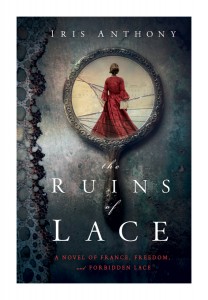Lace, Love and Contraband
by Elizabeth Cole
Author Iris Anthony discusses her novel, The Ruins of Lace

EC: What fascinates you about the forbidden lace trade in the 17th century?
IA: It was the whole idea of connecting the word ‘lace’ and the word ‘smuggling’. In our modern era, we forbid quite a few things from import: drugs, weapons, snakes, even sausages…but lace? It seems so innocuous. And that’s where my fascination first started. What was it about lace that made people go to such great lengths to possess it? And what made kings so eager to control it?
EC: Why did King Louis XIII of France ban the lace trade? Was it simply a matter of economics?
IA: Louis XIII issued at least seven different sumptuary edicts which restricted or prohibited the wearing of lace. The reasons were several. Large amounts of money were being lost across the border in Flanders and in Italy at a time when the King desperately needed money to fill his treasury due to expenses from wars and other pet projects. Another reason is more difficult for the modern mind to understand. Europeans had a great need at that time to keep everyone in their place. Most of the sumptuary edicts were very explicit about who could wear what. These edicts seem like quibbling to us, but they were an important tool for social control. Finally, the King himself was quite ascetic and didn’t approve of conspicuous consumption. Obviously, many of those at court did since he kept issuing sumptuary edicts!
EC: Have you ever made lace yourself? If so did it inspire you to write your novel?
IA: I have made lace! Although I’ve never learned how to make bobbin lace, my grandmother tried to teach me how to make tatted lace one summer. Unfortunately, that was not the year I actually learned how to do it. There’s a particular twist of the wrist that’s needed to tat; it took several more years and an infinite amount of patience on my grandmother’s part for me to acquire that knack.
EC: How did you research your novel?
IA: The first mention I found of lace smuggling was in a French-language article I ran across while researching costuming for a different book. The idea of smuggling lace was so intriguing that even though the information didn’t fit my era, I kept it. When I determined to write the story, I used both English and French language sources. The Victorians had a fascination with lace and lace-making as well as a fascination with history, so many of the details about how lace was actually smuggled came from texts and articles written during the 19th century.
EC: What’s your fascination with Flemish lace in particular — was it the quality or the design?
IA: I love the way Flemish lace patterns are specific to a town or region and I am enchanted with the landscape of ancient Flanders. My real fascination with lace, however, and the spark that fired this story, was the use of dogs in smuggling lace. In one 15-year period over 40,000 dogs were killed as they tried to cross the border. That loss and that cruelty are staggering.
EC: What attracts you as a novelist to writing about 17th-century France?
IA: The 17th century saw the beginnings of the France that we recognize today. The gorgeous French laces, tapestries, and textiles; the fabulous cuisine; the flowering of French literature, theatre, and the visual and decorative arts. But the 17th century also retained much of the savagery of earlier times. That juxtaposition of elegance with wanton cruelty, of elaborate court manners with abject poverty make that place at that time a historical novelist’s dream!
For further details about The Ruins of Lace (Sourcebooks, 2012), please visit http://irisanthony.com
About the contributor: Elizabeth Cole is intrigued by historical novels. She loves words and devises quizzes and sells them for charity. Her mother enjoyed learning lace making.
______________________________________________
Published in Historical Novels Review | Issue 61, August 2012






